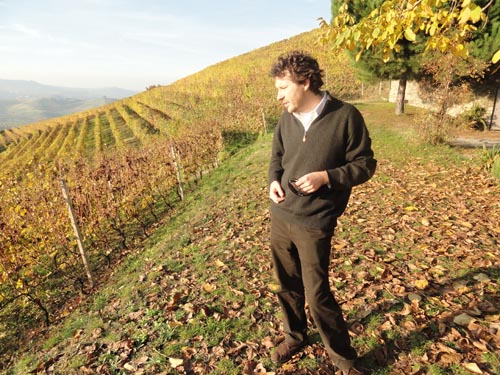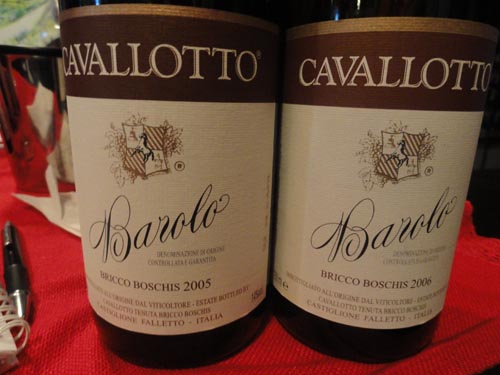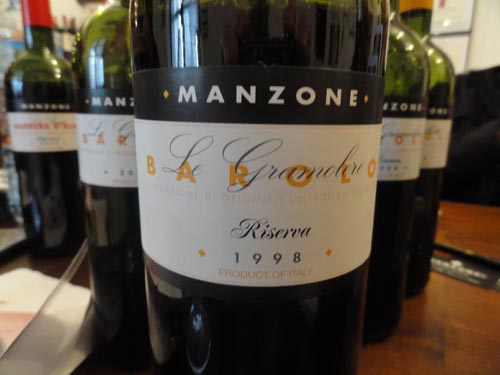A Visit to to Cavallotto and Giovanni Manzone Wineries in Piedmont
A Visit to to Cavallotto and Giovanni Manzone Wineries in Piedmont
(March 15, 2011)
Cavallotto and Giovanni Manzone- Traditional Wine at its Best
Cavallotto and Giovanni Manzone--Traditional Producers
The owner of La Pizza Fresca, one of my favorite pizzerias in NYC, called me at 10:00 PM and said, “Come over. We have a white truffle and old Barolo.” I was there before he hung up the phone. Mark Fornatale, who works for wine importer Michael Skurnik, provided the truffle and we had it shaved on pasta, pizza and risotto. This was a preview for me because two weeks later, I was leaving for Piemonte. Mark represents two traditional producers that I wanted to visit, Cavallotto and Giovanni Manzone, and he said he would make all the arrangements.
F.lli Cavallotto
It was the only sunny day in our stay in Piemonte as we drove up to the Cavallotto winery in the late afternoon. The estate is in Castiglione Falletto on Bricco Boschis in the heart of the Barolo area. I was introduced to their wines in the early 1980’s by the wine writer Sheldon Wasserman and had visited them in 1983, 2007 and in November of 2010.
The Cavalotto’s have been producing wine for five generations. In 1948, they were the first winemakers in the area to dedicate themselves to the vinification of their own grapes and the marketing their wines in bottles.
Alfio Cavallotto, who is an enologist, gave us a tour of the vineyards. The property consists of 65 hectares of which 60 are planted with vines. Alfio said that they have a high number of vines per acre with a corresponding low number of buds per plant, sacrificing quantity for quality. Since 1970 they control the grass covering between the rows of vines to help maintain the natural organic substances in the soil. They have re-introduced natural insect predators allowing for the elimination of pesticides and other toxic chemicals. He also spoke about the soil, the difference between clay and sand in the area and the annual rainfall, as well as the different exposures of the vineyards to the sun. Alfio was a wealth of information and you can find out more at the website.
Bricco Boschis, their cru, is 25 hectares of which 23 hectares are covered with vines. Half of it is planted with Nebbiolo for Barolo and the other half has Barbera, Freisa, Grignolino, Chardonnay and Pinot Noir. They use Slavonic oak barrels of 10, 30, 50, 80 and 100 hl. He also said, with a smile on his face, that they have two barriques. They have both stainless steel and cement tanks and Alfio said that cement tanks ferment the wine at a higher temperature.
Alfio led us in a tasting of his wines.
 |
 |
 |
Langhe Bianco 2009 DOC 100% Chardonnay. The wine is fermented in stainless steel and remains on the lees for 11 months. This is a big ripe wine with a lot of fruit and it proves that a Chardonnay that tastes like Chardonnay can be made.
Dolcetto d’Alba Vigna Scot Bricco Boschis DOC 2009. 100% Dolcetto. Vinification on the skins for 7 days in steel vats and aged in stainless steel for 6 months. Alfio said that for Dolcetto, 2009 was better than 2008 and that 2010 was a very light vintage. This was a Dolcetto with body. It was well balanced, with red fruit aromas, hints of cherries and a touch of bitter almond.
Langhe Freisa 2008 Bricco Boschis DOC 100% Freisa. Maceration on the skins for 5 days with frequent pumping over the must and a few months in stainless steel before release. It has soft tannins with nice fruit and hints of pepper and cloves. This is one of the best examples of this type of wine that I have tasted.
Barbera d’ Alba 2006 “Vigno Del Cuculo” Bricco Boschis DOC 100% Barbera
This is a Barbera that is grown in the Barolo area. It has very good aromas
and flavors, a little like Nebbiolo because the soil here is more complex. Alfio believes that the Barberas from Asti are too simple and light or way over the top because of the use of barriques. He also said the land is less expensive in Asti. This Barbera is four years old and showing no sign of age. I believe that it will age for 10 years or more.
The Nebbiolo vines can be found in the two historical zones of Castiglione Falletto, Bricco Boschis, where the cellars are located, and the Vignolo zone.
Langhe Nebbiolo Bricco Boschis 2007 DOC 100% Nebbiolo (declassified). This is the same vineyard that they get the grapes for Barolo. It is big for a Nebbiolo, tannic with great fruit flavors and aromas and a hint of spice.
Alfio said that Bricco Boschis was divided by the family into three vineyards: San Giuseppe, which may be the finest vineyard, Colle Sudovest and Punta Marcello.
Barolo Bricco Boschis 2005 and 2006 DOCG 100% Nebbiolo. Maceration on the skins for 20 days and aged in Slavonia oak casks of various sizes for three and a half years.
Barolo Riserva 2004 Vignolo DOCG 100% Nebbiolo. Maceration on the skins for 26 days in stainless steel vats and four years in Slovenian oak casks of different sizes. The
Vignolo vineyard is slightly lower than San Giuseppe. I think Bricco Boschis might be the highest vineyard in the zone.
Barolo Riserva Bricco Boschis San Giuseppe 2004 DOCG 100% Nebbiolo. Maceration on the skins for 26 days and aged for four years in Slavonia oak cask of various sizes for four years.
Alifo said that the Barolo area has been fortunate over the last 20 years and that between 1988 and 2010 the only vintages not to buy are 1991, 1992, 2002 and 2003. I agree with him.
The first vintage of Cavalotto Barolo I tasted was the 1971 which I had in the early 1980’s. In 2007 at the winery, I tasted the 1971 again and it was still going strong. Not much has changed over the years as they continue to produce traditional wine and classic Barolo with aromas and flavors of faded roses, tar, tobacco and mushrooms.
The Manzone winery was established in 1925 by Giovanni Manzone and it is located in Monforte d’Alba. It is a small, family run winery consisting of 8 hectares all planted with vines. The average production is 4,100 cases a year. The wines are not clarified or filtered. In 2005, Mauro a trained oenologist joined his father, the present Giovanni at the winery.
It was a cold rainy morning as we made our way along a dirt road that kept on going up and up. Finally, we reached the top of the hill known as “Gramolere” and the winery. I rang the bell and we were greeted by Mauro. He took us into the winery where we met his father Giovanni. When he greeted us I knew that this was a farmer and as Gambero Rosso stated, he “… is an authentic wine man…His wines are so typical they are almost textbook in style, perfectly embodying the true Langhe spirit.” I could not agree more. Giovanni was shy and soft spoken and looked like he had just come in from working in the fields.
In the winery they have 500 liter barrels which looked like they had seen many vintages. Next to them were barrels that were a little larger. When I asked about them I was told they were 700 liter barrels and were traditional in the area. This was very interesting to me because I had never noticed these size barrels before.
Mauro and Giovanni led us in a tasting of their wines.
We started with a Langhe Bianco Rosserto 2009 DOC made from 100% Rossese Bianco. This is an autochthonous variety of the Lange region. Mauro told us that the wine was saved from extinction by his family over 100 years ago. It was in an old family vineyard close to the house. About 30 years ago, Giovanni decided to make wine from this variety which he calls “this special white wine”. It took him 20 years to get official permission for the government to recognize the grape. The wine is fermented for 10 days in 500 liter oak barrels and aged on the lees in the same type of barrels for 12 months with batonnage taking place twice a week. The wine was fruity and mellow with flavors and aromas of peach, orange, acacia and flowers.
Batonnage was not used in the 2000 vintage of this wine. It was fresh with undertones of citrus, and a nice finish and aftertaste. Mauro said that the wine could age between five and ten years but the 2000 was still going strong. Only 2,500 bottles are produced.
Dolcetto d’Alba 2009 DOC from the “le Ciliegie” vineyard. The grapes are harvested the first week of September and maceration takes place for seven days. It is aged in stainless steel tanks for 11 months. The wine is fruity with blackberry overtones and hints of violets.
Barbera d’Alba 2007 DOC “La Serra” Riserva the grapes are picked in the La Serra vineyard in the middle of September. Maceration is on the skins for ten days. The wine is aged in 700 liter barrels for 16 months. This was an interesting wine with aromas and flavors of red fruit, sour cherries and hints of tobacco.
Nebbiolo d’Alba 2008 DOC the grapes come from the “Le Gramolere” vineyard and are picked in the middle of October. Maceration is on the skins for seven days. The wine is aged in 700 liter casks for six months. Good red fruit and a hint of spice.
Barolo “Le Gramolere” 2006 DOCG the grapes are harvested in the middle of October and there is skin contact for 30/40 days. It is aged in 25 HL casks for 30 months. This is a very complex wine with a lot of tannin. It has aromas and flavors cherries, raspberries, spice and balsamic.
2004 Mauro said was a great vintage and they made a Riserva which they only make in the best years. He said the wine was aged in 500-700 liter barrels for 48 months. This is a big wine but elegant at the same time. We also tasted the 1998 Riserva, a year that was overshadowed by the 1997. However Giovanni felt that 1998 was a great vintage similar to the 2004. I had to agree. This wine will age for a long time.
We tasted the Barolo 2008 DOCG Bricat from barrel. It had the aromas and flavors of Pinot Noir. These were the same Pinot Noir aromas and flavors we tasted at Elvio Congo when Valter gave us a barrel sample of his 2008. There must be something about that vintage. I cannot wait to taste them from the bottle to see how they have developed.
Barolo Bricat 2006 DOCG the grapes were picked in the middle of October. Maceration is on the skins for 15 days. 50% of the wine is aged in 500 liter barrels and 50% in 700 liter barrels for a minimum of 24 months. It has flavors and aromas of blueberries, blackberries with a hint of chocolate and walnuts. It is not as big a wine as the “Le Gramolere”.
Giovanni Manzone has a very good website
Every time that I travel to Piemonte I see changes. For many years I feared that the entire Langhe wine production would veer toward the “international style” of wine making. This method trades off the wonderful authenticity and purity-of-character of the Nebbiolo grape for faster maturation and more immediate gratification. The use of small, new, French oak barriques accomplishes this but adds flavors of oak and vanilla to the wines; flavors that the original Barolo producers never envisioned or desired.
Although it is true that “degustibus non disputandum” (personal taste can’t be disputed), if the reader wants to experience Barolo in the form in which it was originally conceived and made, producers like Cavallotto and Manzone, and last issue’s Elvio Cogno, are the guarantors of that tradition. As long as these families continue their fine work, those of us who want authentic Barolo wines will be able to get them.
Finally, I am happy to mention that many of the Barolo houses that veered toward the use of new oak and international style are turning back somewhat; and trying to get closer to the more authentic methods that Cogno, Cavalotto, and Manzone never forgot.
www.loveofpizzatour.com With Roberto of Keste, Michele and me, Naples, Rome and everything in between.
Listen to Charles Scicolone on Wine every Wednesday at 6:05 PM on Valerie’s New York www.wor710.com internet radio and on demand.
.
This work may not be reproduced, in whole or in part, without prior written permission.
Questo lavoro non può essere riprodotto, in tutto o in parte, senza permesso scritto.



